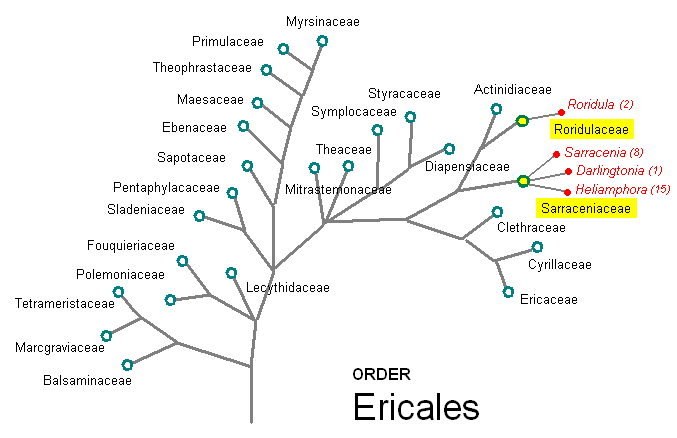Scientific name Ericales Rank Order | Clade Angiosperms Higher classification Asterids | |
 | ||
Lower classifications | ||
The Ericales are a large and diverse order of dicotyledons, including, for example, tea, persimmon, blueberry, Brazil nut, and azalea. The order includes trees, bushes, lianas, and herbaceous plants. Together with ordinary autophytic plants, the Ericales include chlorophyll-deficient mycoheterotrophic plants (e.g., Sarcodes sanguinea) and carnivorous plants (e.g., genus Sarracenia).
Contents

Many species have five petals, often grown together. Fusion of the petals as a trait was traditionally used to place the order in the subclass Sympetalae.

Mycorrhiza is an interesting property, frequently associated with the Ericales. Indeed, symbiosis with root fungi is quite common among the order representatives, and three kinds of it can be found exclusively among Ericales (namely, ericoid, arbutoid and monotropoid mycorrhiza). In addition, some families among the order are notable for their exceptional ability to accumulate aluminum.

Ericales are a cosmopolitan order. Areas of distribution of families vary largely - while some are restricted to tropics, others exist mainly in Arctic or temperate regions. The entire order contains over 8,000 species, of which the Ericaceae account for 2,000-4,000 species (by various estimates).

Economic importance

The most commercially used plant in the order is tea (Camellia sinensis) from the Theaceae family. The order also includes some edible fruits, including kiwifruit (Actinidia deliciosa), persimmon (genus Diospyros), blueberry, huckleberry, cranberry, Brazil nut, and Mamey sapote. The order also includes shea (Vitellaria paradoxa), which is the major dietary lipid source for millions of sub-Saharan Africans. Many Ericales species are cultivated for their showy flowers: well-known examples are azalea, rhododendron, camellia, heather, polyanthus, cyclamen, phlox, and busy Lizzie.
Classification
These families are typical of newer classifications. Those marked with an asterisk are recognized in the APG III system.
These make up a basal group of asterids. Under the Cronquist system, the Ericales included a smaller group of plants, which were placed among the Dilleniidae:
